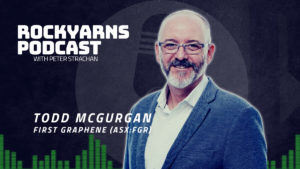First Graphene throws down the gauntlet with release of PureGRAPH

Pic: Justin Paget / DigitalVision via Getty Images
Special Report: Advanced materials company First Graphene has developed what it believes is the best graphene product line in the world, throwing down the gauntlet to the graphene industry with its release of PureGRAPH, with extensive technical data that can be relied upon by customers.
“It is time for graphene producers to be made accountable for what they are promoting, to both industry and investors.”
“It is all about quality and accuracy. It is time to grow beyond hot air and promotion. It is about deliverability,” says Warwick Grigor, First Graphene (ASX:FGR) chairman.
Graphene is a promising nanomaterial that can greatly enhance the performance of a wide range of materials used in industry, from something as basic as concrete through to batteries, elastomers, fire retardants paints, polymers and water filtration.
However, as with all new technologies, it takes time to be universally adopted.
There have been two obvious hurdles to the commercialisation of graphene-based products to date. One is the availability of reliable supply and the other has been the quality of graphene produced.
Perth-based First Graphene believes it has addressed both of these issues, catapulting it to world leadership in the race to commercialise graphene.
Earlier this year, it announced the successful commissioning of its bulk graphene production unit at its Henderson facility, south of Fremantle, and is now supplying trial parcels of graphene to a wide range of potential customers around the world.
Given that it is a new product and production engineers need to time to test the suitability and effectiveness of graphene in their products, and then processes have to be modified to introduce graphene into the production line, First Graphene expects time frames of 6-24 months for each customer to graduate to becoming regular purchasers of graphene.
However, as the bank of know-how increases with experience, this time frame will shrink over time with greater familiarity.
“Most of the work that has occurred in the graphene industry over the past 10 to 15 years has been at the small scale and has an adverse impact on operating costs,” Mr Grigor tells Stockhead.
By contrast, FGR’s process enables very low capital costs and it expects to be firmly placed in the lowest cost decile of operating costs.
“We can produce graphene in bulk and on demand, at very low cost, and we are uniquely positioned to finally commercialise this incredible material by offering reliable supply.”
- Subscribe to our daily newsletter
- Bookmark this link for small cap news
- Join our small cap Facebook group
- Follow us on Facebook or Twitter
The second point, that of quality, has been the focus of FGR over the last five months, culminating with the release of its PureGRAPH product range.
Extensive testing and characterisation of its three main graphene products, being platelets of 5, 10 and 20 microns in diameter, has enabled the publication of a detailed product specification sheets for use by industry, with confidence as to reliability and repeatability of the quality of the products.
By contrast, almost all other graphene producers either don’t make this technical information available, or they are very selective and refer only to their best features as opposed more useful complete characterisation.
“This is so that industry knows what it is getting, with confidence” says Mr Grigor. “We want to be able to provide customers with as much technical information as possible.”
The company has already secured a world-class affiliation, being invited to be one of three first-tier partners in the University of Manchester’s $107 million Graphene Engineering and Innovation Centre (GEIC).
GEIC was established to accelerate the commercialisation of graphene by bringing together industry operators like First Graphene and university scientists under one roof.
“The partnership is incredibly important because it shows that we are intimately involved in the commercialisation process,” Mr Grigor said.
Mr Grigor says one’s imagination is the only barrier to the potential impact graphene can have on a global scale, adding that the company’s current focuses are on fire retardants, super-capacity batteries, polymers, elastomers and concretes, though there are many more uses under investigation.
“It is without doubt the area of greatest technological disruption in materials,” he says. “The growth curve is going to continue for decades and FGR will be at the vanguard.”
This special report is brought to you by First Graphene.
This advice has been prepared without taking into account your objectives, financial situation or needs. You should, therefore, consider the appropriateness of the advice, in light of your own objectives, financial situation or needs, before acting on the advice.
If this advice relates to the acquisition, or possible acquisition, of a particular financial product, the recipient should obtain a disclosure document, a Product Disclosure Statement or an offer document (PDS) relating to the product and consider the PDS before making any decision about whether to acquire the product.
UNLOCK INSIGHTS
Discover the untold stories of emerging ASX stocks.
Daily news and expert analysis, it's free to subscribe.
By proceeding, you confirm you understand that we handle personal information in accordance with our Privacy Policy.








